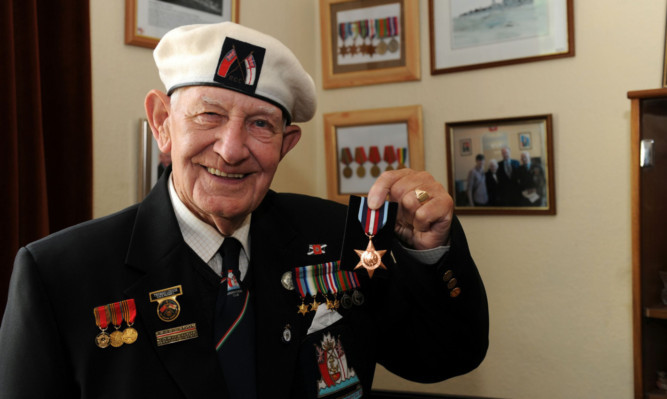Nearly 70 years after risking life and limb in the Arctic convoys, Fife hero veteran Tom Lennie has been recognised for his bravery.
Newburgh resident Mr Lennie, 88, was at last presented with an Arctic Star medal recognising his role in maintaining supply links to British allies on the Eastern Front during the Second World War.
He had already received his medal by post, but Scottish Secretary Michael Moore wanted to make an official presentation and invited him to a reception at the Scotland Office in Edinburgh to celebrate Armed Forces Day.
Edinburgh veteran Arthur Southall, who served on HMS Loch Insh, was also invited.
Mr Lennie said: “The Scotland Office made me feel very welcome. Mr Moore was very nice and shook our hands. It was a great night out and they looked after us very well.
“It was a great honour to get the Arctic Star medal.”
As part of the crew of HMS Red Mill, Mr Lennie was involved in detecting enemy submarines off the coast of Russia. He was part of a mission which claimed the lives of more than 3,000 sailors.
Working in icy waters, sailors battled frosts and storms, and Mr Lennie survived his ship getting hit by an enemy torpedo.
“It was terrible,” he said. “I wouldn’t like anybody else to go through what we did on the Russian convoys.
“It’s difficult to talk about because it can bring tears to your eyes. We lost so many people.”
Another medal is on its way to Mr Lennie, this time from Russia. The UK Government at first tried to prevent Arctic convoy veterans from accepting the Russian medal but has since changed its mind.
The Arctic convoys were made up of vessels which travelled from Britain to northern Russia to resupply the Soviet Union. The convoys delivered vital aid, running the gauntlet of enemy submarine, air and surface ship attacks.
By May 1945, the Arctic route had claimed 104 merchant and 16 military vessels. The Arctic Star recognises the invaluable and daring service the allied sailors performed.
Mr Moore said: “Armed Forces Day is a time for us to reflect on and give thanks for those who serve our country today and who have done so in the past.
“It helps raise awareness of theimportant role they play and the sacrifices they make on our behalf and, in return, allows them to see the huge amount of public support which exists for them throughout the country. Our thoughts are also very much with those on active duty in Afghanistan and their families.
“This year is particularly poignant, given the recognition and decoration being given to those veterans who served on the Arctic convoys in the Second World War and I am proud to have presented medals to Arthur and Thomas.
“Next year will also see the commemoration of the First World War centenary, with Glasgow playing a central role as we remember the generation which fought in that conflict.”
Colonel Martin Gibson, executive chairman of Veterans Scotland, added: “I am delighted the secretary of state for Scotland hosted this event to mark Armed Forces Day at the Scotland Office.
“Veterans throughout Scotland and the UK value the support of the public and events like this are a great way to show the esteem in which they and their service to their country is held.
“The presentation of the Arctic Star medals to two Scottish veterans is a key recognition of the difficult and dangerous job they did in the Second World War and it was a privilege to see them receive their medals.”
